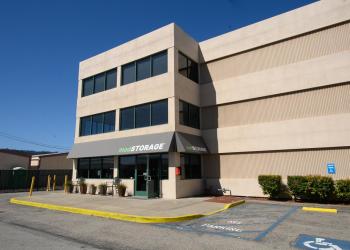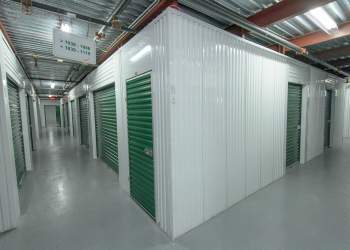A: Indoor storage units are located within a building, offering enhanced protection from the elements, better climate control options, and generally higher security measures than outdoor storage units. They are ideal for sensitive or valuable items that require protection from temperature fluctuations, humidity, or security risks. Outdoor storage units might be more accessible directly from your vehicle and can be less expensive, but they offer less protection against environmental factors.




modSTORAGE | Indoor Storage
Indoor Personal & Self-Storage near Monterey
Keep your items safe from all the elements with modSTORAGE
Introduction to Indoor Storage
Indoor storage solutions represent a versatile and secure option for both individuals and businesses looking to safeguard their belongings. Unlike outdoor storage, which might expose items to various environmental conditions, indoor storage offers a controlled environment that significantly enhances the protection of stored goods.
Understanding Indoor Storage:
Indoor storage units are typically housed within a larger building, providing an extra layer of security and insulation from external conditions. These units can vary widely in size, from small lockers suitable for a few boxes of personal items to large rooms that can accommodate furniture, business inventory, or even vehicles in some cases.
Comparing Indoor to Outdoor Storage:
The primary distinction between indoor and outdoor storage lies in accessibility and protection. Indoor storage units are accessed through interior hallways, offering better temperature control, reduced exposure to dust, pests, and moisture, and generally more advanced security features than their outdoor counterparts. This makes indoor storage particularly appealing for sensitive items such as electronics, documents, artwork, and textiles.
Advantages of Indoor Storage
Enhanced Security:
Indoor storage facilities often boast comprehensive security measures, including surveillance cameras, alarm systems, gated access, and sometimes on-site staff. The indoor setting provides an additional barrier to entry, making these units less susceptible to theft or vandalism.
Environmental Protection:
One of the most significant benefits of indoor storage is protection from weather-related damage. Units inside buildings shield belongings from rain, snow, extreme temperatures, and sunlight, reducing the risk of water damage, fading, or thermal wear.
Climate Control:
Many indoor storage facilities offer climate-controlled units, maintaining a consistent temperature and humidity level. This is crucial for storing items that can be damaged by extreme cold, heat, or fluctuations in humidity, like wood furniture, musical instruments, photographs, and wine.
Types of Indoor Storage Solutions
Self-Storage Units:
The most common type of indoor storage, these units range in size and are rented on a month-to-month basis. They're ideal for a wide variety of storage needs, from household decluttering to business inventory.
Climate-Controlled Units:
Specially designed to maintain a stable environment, these units are essential for temperature or humidity-sensitive belongings. They're commonly used for storing antique furniture, electronics, art collections, and important documents.
Specialized Storage Options:
For needs that go beyond the ordinary, some facilities offer specialized indoor storage solutions:
- Document Storage: Secure units designed for businesses to archive sensitive paperwork.
- Wine Storage: Temperature and humidity-controlled units for preserving the quality of wine collections.
- Art Storage: Spaces with controlled light, temperature, and humidity to protect artwork.
Who Needs Indoor Storage?
Businesses: From retail stock to archival documents, companies use indoor storage to manage excess inventory or secure sensitive information.
Individuals: Whether moving, downsizing, or simply seeking to declutter without discarding valuable possessions, individuals find indoor storage offers an ideal solution.
Collectors: For those who collect items like wine, art, or antiques, the controlled environment of indoor storage is indispensable for preservation.
In crafting a comprehensive page on indoor storage, these sections serve as a foundational overview, highlighting the significance, benefits, and applications of indoor storage solutions. Subsequent sections will delve deeper into each topic, providing readers with a thorough understanding and guiding them toward making informed decisions about their storage needs.
FAQ: About Indoor Storage
A: Items that benefit from indoor storage typically include electronics, wooden and leather furniture, artwork, important documents, photographs, wine collections, and any other items that might be sensitive to temperature, humidity, or require additional security. Indoor storage is also preferred for long-term storage needs where items need to be preserved in their current condition.
A: While storage units provide an excellent solution for storing inventory, documents, and equipment, using a unit as an operational office space or storefront is generally prohibited due to zoning laws and facility policies. However, they can be a cost-effective solution for businesses looking to store excess inventory or archives.
A: Yes, most facilities prohibit the storage of perishable items, flammable liquids and gases, illegal substances, and live animals. It's essential to check with your chosen facility for a detailed list of prohibited items to ensure compliance and safety.
A: The security of indoor storage facilities can vary, but top-tier facilities typically offer surveillance cameras, controlled access gates, individual unit alarms, and sometimes on-site security personnel. When choosing a facility, look for these features to ensure the highest level of security for your stored items.
A: Access policies vary by facility. Some offer 24/7 access through secure, personal entry codes or keycards, while others have set access hours. If you anticipate needing frequent or late-night access, look for a facility that offers 24/7 entry to accommodate your schedule.
A: Rental periods are flexible, with many facilities offering month-to-month leases. There typically aren't maximum rental periods, but some facilities may offer discounts for long-term commitments. Minimum rental periods, if any, are usually short, often starting from one month.
A: While not always required, insurance is highly recommended to protect your items against potential loss or damage. Some facilities offer insurance plans, or you might be able to extend your homeowner’s or renter’s insurance to cover items stored off-premises. It’s wise to discuss options with your insurance provider and the storage facility.
By addressing these more detailed inquiries, potential and current customers can gain a comprehensive understanding of indoor storage facilities, helping them make informed decisions about their storage needs.
Choosing the Right Indoor Storage Facility
Factors to Consider:
Selecting the perfect indoor storage facility goes beyond just finding a space to stash your belongings. It involves a careful assessment of several crucial factors to ensure your items are stored safely, accessibly, and affordably.
- Location: Proximity to your home or business can significantly impact convenience. Consider how often you'll need to access the unit and choose a location that minimizes travel time and costs.
- Security: Evaluate the security measures in place. Look for facilities with 24/7 surveillance, individual unit alarms, secure access controls, and on-site security personnel. A secure facility can offer peace of mind, knowing your items are well-protected.
- Access Hours: Ensure the facility's access hours align with your schedule. Some indoor storage providers offer round-the-clock access, while others may have more limited hours. Consider your access needs, especially if you anticipate needing items during odd hours or emergencies.
- Climate Control: If you're storing items sensitive to temperature fluctuations or humidity, such as electronics, wood furniture, or collectibles, a climate-controlled unit is essential. Verify the range of temperature and humidity control to ensure it meets your specific needs.
- Costs: Understand the pricing structure, including monthly rates and any additional fees (for security, climate control, insurance, etc.). Comparing costs across several facilities can help you find the best deal that fits your budget.
- Reputation and Reviews: Research the facility’s reputation. Online reviews, testimonials, and word-of-mouth recommendations can provide insight into customer satisfaction and any potential issues.
Evaluating the Size and Type of Storage Needed:
Estimate how much space your items will require. Many facilities offer a range of unit sizes, and some might provide assistance or tools to help you decide on the size. Also, consider the type of storage (standard vs. climate-controlled) based on the items you're storing.
Understanding Contract Terms and Insurance Options:
Carefully review the rental agreement for any long-term commitments, penalties, or specific terms regarding unit access and vacating procedures. Check if the facility offers insurance or if you'll need to arrange your own coverage to protect your items against potential damage or loss.
Best Practices for Packing and Inventory Management:
Proper organization within your storage unit can save time and prevent damage. Use sturdy, labeled boxes for easy identification and stack them strategically to maximize space and ensure stability. Employ shelving units to keep items off the floor and further optimize space.
Tips for Maximizing Space and Maintaining Accessibility:
Place items you may need to access more frequently near the front of the unit and create a clear path for easy access to items at the back. Utilize vertical space by stacking boxes and bins, ensuring heavier items are at the bottom to prevent toppling.
Utilizing Technology for Inventory Tracking and Management:
Implementing an inventory management system can streamline operations, especially for businesses using storage for inventory or equipment. Use barcodes or RFID tags to track items, and consider cloud-based software to access your inventory list from anywhere, facilitating efficient retrieval and stock management.
Organizing your indoor storage unit effectively not only protects your stored items but also enhances operational efficiency by making it easier to find and access what you need when you need it. By considering these organizational strategies and leveraging technology, businesses can make the most out of their indoor storage solutions.
When selecting an indoor storage facility, the security of your stored items is paramount. High-quality security measures not only protect your belongings but also provide peace of mind. Here's what to look for and consider regarding security in indoor storage facilities:
Advanced Security Features to Look For:
- Surveillance Systems: Ensure the facility employs around-the-clock video surveillance to monitor and record activities within and around the storage units.
- Controlled Access: Facilities should have secure access controls, such as electronic gate access, keycode entry to buildings, and individual unit locks, to restrict entry to authorized individuals only.
- Individual Unit Alarms: Some facilities offer alarms for each storage unit, providing an added layer of security by alerting facility staff or a monitoring service if an unauthorized entry is detected.
- Well-Lit Premises: Adequate lighting throughout the facility deters unauthorized access and vandalism, making it safer for you to visit your unit after dark.
- On-Site Staff or Security Personnel: The presence of staff or security personnel can significantly enhance a facility's security by providing constant oversight and rapid response to any security breaches.
Importance of Data Protection for Stored Documents and Digital Media: For businesses storing sensitive information or valuable data, considering how well these items are protected is crucial. In addition to physical security measures, evaluate whether the facility offers climate-controlled units to protect against environmental damage that could affect electronic media.
The cost of indoor storage can vary widely based on several factors. Understanding these can help you budget effectively and ensure you're getting the best value for your needs.
Understanding Pricing Structures and Additional Fees:
- Rental Rates: Monthly rental rates depend on the unit size, location of the facility, and any special features like climate control.
- Insurance: Some facilities require you to purchase insurance as an additional cost, either through them or independently, to cover your stored items.
- Security and Climate Control Premiums: Enhanced security features and climate-controlled units often come at a premium.
Cost Comparison Between Different Storage Options: Comparing costs between traditional indoor storage units, climate-controlled options, and specialized storage services can help identify the most cost-effective solution for your specific requirements.
Tips for Budgeting and Minimizing Storage Costs:
- Only Rent the Space You Need: Utilize space-saving packing and organization strategies to avoid paying for larger units than necessary.
- Look for Discounts and Promotions: Many storage facilities offer deals for new customers, long-term rentals, or specific payment methods that can reduce your overall costs.
- Review Your Storage Needs Regularly: Periodically assess whether you still need all the items in storage or if you can downsize to a smaller, less expensive unit.
Accessibility Features and Considerations for Businesses: When choosing an indoor storage facility, consider how easily and frequently you'll need to access your unit. Facilities offering 24/7 access through secure, personal entry codes provide the greatest flexibility, especially for businesses that may need to retrieve items unpredictably.
Balancing Security with Convenient Access to Storage Units: Finding a facility that offers both stringent security measures and convenient access is crucial. Evaluate the trade-offs between heightened security features (which may limit access) and the need for frequent, easy entry to your unit.
Accessibility is a critical aspect of indoor storage, especially for time-sensitive or frequently used items. Ensuring easy access without compromising on security allows businesses and individuals to make the most of their storage solutions, enhancing overall efficiency and satisfaction.
Proper maintenance of your indoor storage unit is essential for ensuring the longevity and safety of your stored items. Regular checks and an organized approach can prevent issues such as moisture damage, pests, and clutter, which could otherwise compromise the condition of your belongings.
Regular Checks and Maintenance Tips:
- Regular Visits: Schedule periodic visits to your unit to inspect the condition of your items and the unit itself. Look for signs of moisture, pests, or any other potential problems.
- Cleanliness: Keeping your unit clean reduces the risk of pests and mold. Use dust covers on furniture and boxes to protect them from dust and dirt.
- Proper Ventilation: If your unit is not climate-controlled, consider using silica gel packets or other moisture-absorbers to prevent dampness, especially if storing items prone to moisture damage.
How to Address Issues with Humidity or Pests:
- Humidity Control: In units without built-in climate control, portable dehumidifiers can help maintain a dry environment. However, ensure that the facility allows their use and that you have a way to regularly empty the unit if needed.
- Pest Prevention: Use pest repellent sprays or devices as a preventative measure. Avoid storing perishable items that could attract pests, and ensure that all items, especially fabrics and papers, are clean and dry before storage to not attract insects or rodents.
- Optimizing Storage Conditions Over Time:
- Reevaluate Stored Items: Over time, your storage needs may change. Regularly assess what you have stored and decide if anything can be removed, donated, or sold, which can help you downsize to a smaller unit or better organize the existing one.
- Update Inventory: Keeping an updated inventory list helps track all items in storage, making it easier to find things when you need them and ensuring nothing is forgotten or neglected.
Maintaining an indoor storage unit requires a proactive approach to prevent common storage issues. By regularly checking your unit, keeping it clean and organized, and addressing any environmental concerns promptly, you can ensure your stored items remain in the best possible condition.
Understanding the legal and compliance aspects related to indoor storage is crucial for both individuals and businesses. Different regions and industries may have specific regulations governing what can be stored and how items should be managed.
Regulatory Considerations for Storing Business Documents and Items:
- Businesses must be aware of any legal requirements for document retention and ensure that their storage practices comply with regulations such as GDPR for personal data or industry-specific guidelines for sensitive materials.
Compliance with Industry-Specific Storage Requirements:
- Certain industries, such as healthcare, legal, and finance, have stringent requirements for storing sensitive materials, including client records, patient information, and financial documents. It’s important to choose a storage solution that meets these compliance needs, often necessitating climate-controlled and highly secure storage options.
Conclusion: The Value of Choosing Indoor Storage
Indoor storage offers a secure, versatile, and convenient solution for a wide range of storage needs. Whether you’re looking to protect valuable possessions from environmental factors, require additional space for business inventory, or need a temporary home for personal belongings during a transition, indoor storage provides a solution. By carefully selecting a facility, preparing and maintaining your items, and understanding the associated legalities, you can leverage indoor storage to enhance your space management effectively.
Encouraging potential users to evaluate their needs and explore indoor storage options can facilitate more informed decisions, ensuring they find the best storage solutions to support their goals.
